PTC Updates Creo
New app for creating or validating modular product designs in 3D early in cycle introduced.
May 16, 2012
By Anthony J. Lockwood
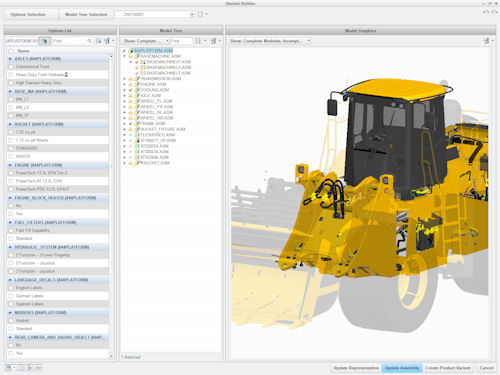 |
| Creo Options Modeler enables users to couple allowable product options, parts structure, and 3D models. Image courtesy of PTC. |
PTC (Needham, MA) has released version 2.0 of its Creo 2.0 product design software. With Creo 2.0, PTC introduces a new role-specific app supporting modular product design that extends the way organizations can approach concept design and delivers significant productivity enhancements to its existing Creo apps. The Creo 2.0 release delivers more than 490 enhancements to the Creo app family for parametric and direct modeling, sketching, and 2D design. In a related announcement, PTC also announced the 10.1 version of its Windchill PLM (product lifecycle management) software.
PTC calls its new role-specific app the Options Modeler, and describes it as being built for designers who need to create or validate modular product designs in 3D early in a design cycle. The new app, which will be available this summer, is said to deliver a dedicated set of capabilities to build accurate, up-to-date, precise 3D-based product assemblies, irrespective of size or complexity. PTC adds that when Creo Options Modeler is used with Creo Parametric 3D CAD, it enables teams to validate precise mass and center of gravity as well as check and resolve such issues as interference for modular designs. The Options Modeler is the tenth app in the Creo family.
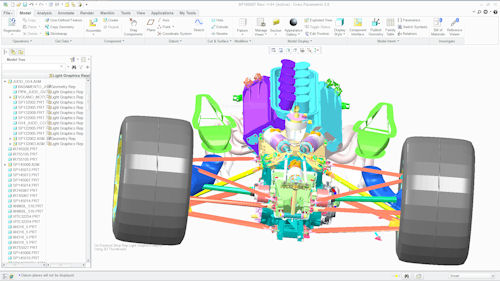 |
| Creo 2.0, says PTC, loads large assemblies up to 10 times faster than previous versions. Image courtesy of PTC. |
Creo Options Modeler, says PTC, contributes to the company’s AnyBOM Assembly technology vision, a strategy that is intended to give teams the power and scalability needed to create, validate, and reuse information for modular product architectures. By combining Creo Options Modeler with Windchill Product Lifecycle Management (PLM) software, explains PTC, manufacturers can generate and validate precise 3D representations of product configurations defined by an individual bill of materials (BOM).
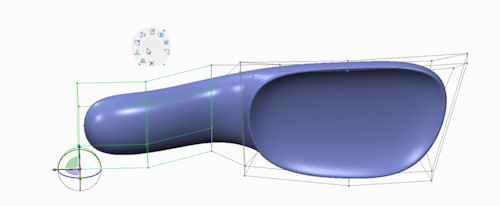 |
| PTC says that the freestyle design capabilities in Creo Parametric enable industrial designers to create even the most complex shapes quickly. Image courtesy of PTC. |
PTC reports that it has enhanced Creo Parametric 2.0 with new capabilities for freeform surfaces, working with 3D cross sections, measurements, and tracking changes. According to PTC, the enhanced freestyle capabilities in Creo Parametric 2.0 allow designers to quickly and easily create more refined surfaces with higher levels of detail while maintaining top-level control over the general freeform shape. This, says PTC, significantly reduces the time to move concepts to precise, highly detailed aesthetic product designs.
Creo Parametric 2.0 is said to provide designers working with 3D cross-sections complete product insight with new, intuitive, and fast ways to create and dynamically re-position the sections, including instant access directly from the model tree. Real-time interference detection within a section together with 2D visualization is available, which reportedly can help designers fully visualize the design and design changes, as well as detect and address potential issues early in the design process.
 |
| Creo 2.0 Parametric. Image courtesy of PTC. |
The new streamlined measure tool in Creo Parametric 2.0 is described as offering significant performance and usability improvements, helping designers gain detailed insight into key dimensions and measurements of any selected surface quickly. The tool enables control over how and where measured results display on-screen, and it allows for simple re-use of the displayed values into other applications, such as a Word document.
The new track changes capability in Creo Parametric 2.0, the company explains, allows designers to view, accept, or reject model changes made by others using Creo Direct. This, the company adds, means that designers can now work with a broader range of colleagues across the company while still maintaining full control of how changes are reflected in the parametric model and ensuring that design intent is fully maintained.
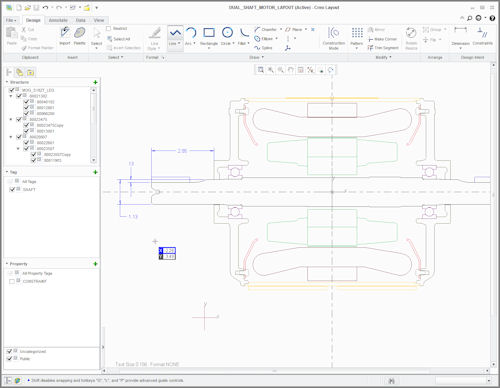 |
| Creo Layout provides 2D drafting tools. Image courtesy of PTC. |
In Creo Layout 2.0, PTC says that it is helping to solve the specific problem of transitioning from 2D to 3D. Creo Layout 2.0 reportedly allows users to easily create a layout of complex assemblies, quickly explore design alternatives, import a variety of 2D CAD file types, sketch and modify 2D geometry, organize information with groups, tags and structure as well as dimensions, notes and tables. Once created, a 2D design in Creo Layout can serve as the basis for 3D models, allowing users to create assemblies in 2D or reference 2D geometry to create part features. Any changes made in 2D are reflected in 3D upon regeneration.
New capabilities in Creo Direct can help accelerate bid-proposals and early concept design, says PTC. Casual users can now quickly and easily create new compelling 3D designs. They also can easily modify models by reference to existing geometry of available parts and assemblies. New intelligent snapping capabilities are said to allow users to quickly and precisely place multiple parts and assemblies into position.
“The release of Creo 2.0 demonstrates PTC’s unwavering commitment to deliver against our Creo strategy and solve the chronic challenges customers face with traditional CAD tools,” said Michael Campbell, divisional general manager MCAD segment, PTC, in a press statement. “Built on PTC’s heritage of innovation, Creo rethinks the very nature of product design, increasing collaboration and protecting data fidelity across any user role, any design mode, or any data source. PTC is also delivering the first technology component in its vision for managing modular product designs driven by the BOM.”
Version 10.1 of PTC’s Windchill PLM software is now integrated with the company’s recently acquired Integrity software system lifecycle management technology. Windchill 10.1 also introduces enhancements to the product’s capabilities in a wide range of areas, says PTC. In addition, Windchill Mobile is now available from the Apple iTunes store for the iPad and iPhone.
PTC says that the integration of Windchill and Integrity combines the collaborative requirements authoring and management capabilities of Integrity with the flow-down traceability offered in Windchill. This combination is said to deliver comprehensive requirements management capabilities and enables manufacturers to improve product quality, reduce rework, and improve time to market. Additionally, Windchill now integrates with Integrity’s software change and configuration management capabilities to manage defects and issues, as well as enable software releases to be synchronized with product configurations.
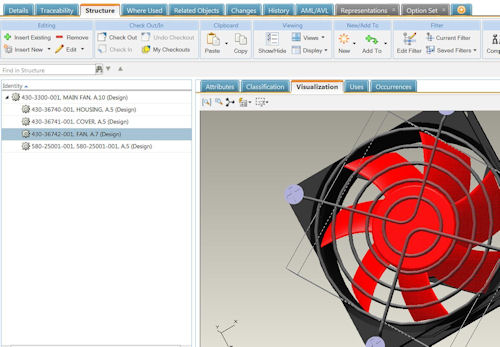 |
| Selecting a component within the Windchill part structure highlights the component within the embedded visualization. Alternatively, users can select a component within the visualization to identify a component within the structure. Image courtesy of PTC. |
Windchill’s core configuration management capabilities have been further enhanced to provide advanced support for configurable products. With a new version of its FlexPLM technology, companies can now reference CAD models managed in a Windchill environment. This is said to give retail product designers greater visibility and understanding of how to work with products that have both hard and soft goods (e.g. a chair s frame and fabric). PTC also reports that it has enhanced how companies can accurately track product cost estimates and maintain related historical information by managing and displaying product cost information in multiple currencies.
The new Windchill Mobile app gives users instant anytime, anywhere access to current product and process information. Windchill Mobile includes a shake and break capability that allows users to explode a product assembly by simply shaking their mobile device to see the internal parts in greater detail. Windchill also now supports Apple users even if they aren’t on a mobile device with support for Mac OS X.
Creo Options Modeler is available immediately as an extension of Creo Parametric. PTC expects Creo Options Modeler to be available as a stand-alone app in June 2012. All other Creo 2.0 apps are available now. For more information, visit PTC’s Creo product page.
Go here for more on Creo Options Modeler.
Download the Creo Parametric data sheet.
Download the Creo Layout data sheet.
Watch the “Introduction to Creo Layout” video.
Access a video and PDF library of Creo user stories.
Download details on Creo Ready software and hardware partners.
Go here to learn more on Windchill.
Go here to learn more about Integrity.
See why DE’s editors selected PTC’s Creo 2.0 as their Pick of the Week.
Sources: Press materials received from the company and additional information gleaned from the company’s website.
Subscribe to our FREE magazine, FREE email newsletters or both!
About the Author
Anthony J. Lockwood is Digital Engineering’s founding editor. He is now retired. Contact him via [email protected].
Follow DE





